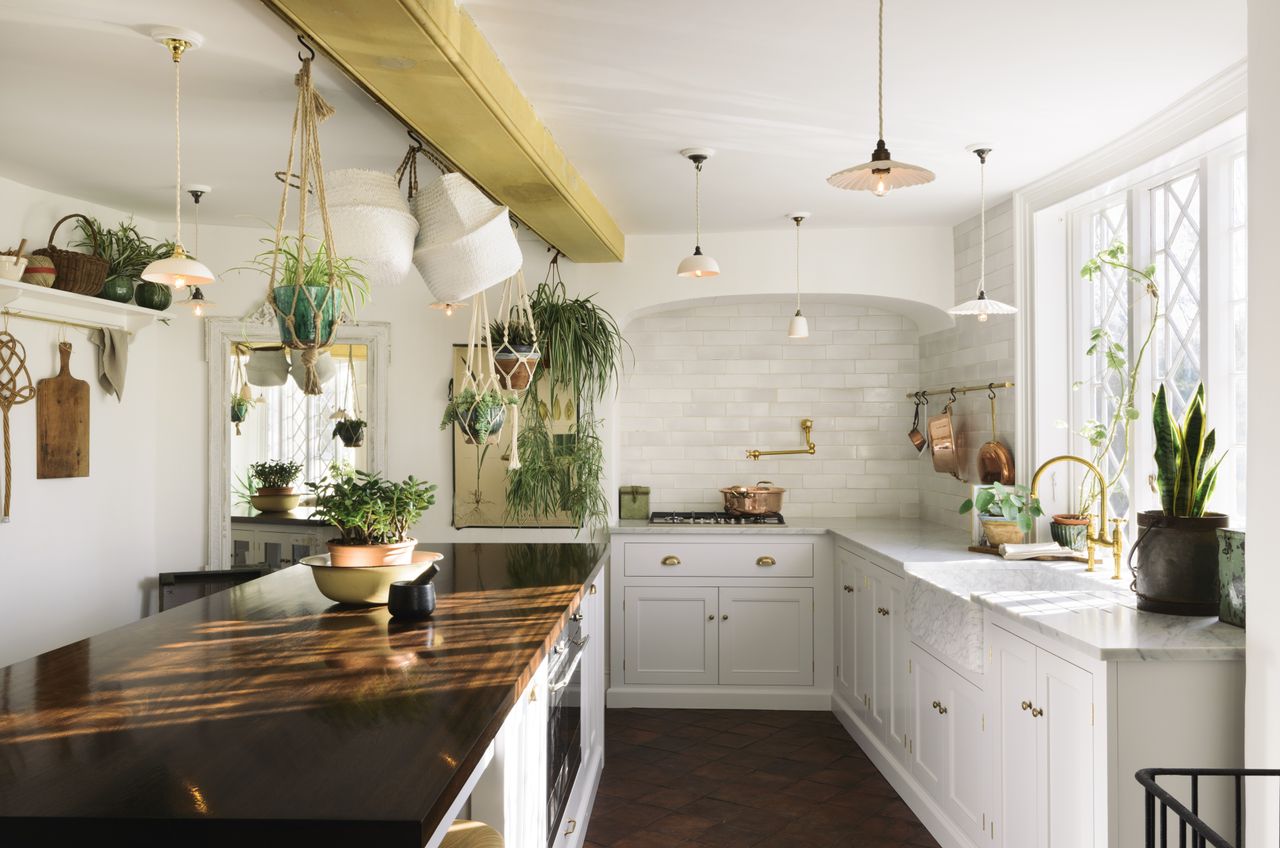
If you’re planning your dream room, discovering new kitchen costs will be at the top of your agenda. Whether you‘re replacing an existing kitchen in the same space, or building on to your home and relocating the kitchen at the same time, being aware of likely costs will help you plan your project.
It’s not only important to know what the final bill might be, but also to understand what you should budget for the individual elements that are all part of your kitchen ideas so that you can get your design just right – and that’s where our guide comes in. We’ve got the details on what you should expect to pay for everything from cabinets to worksurfaces, appliances, sinks, and taps, as well as what total costs might be.
But whether you’re planning a large kitchen or a smaller room, and shopping in DIY stores or specialist kitchen retailers, it’s important to make the most of your spend and we’ve also got expert advice on how to make your money go further and maximize your spend right here. And you can check out the best kettles and best coffee machines when you’re done to add the perfect finishing touches.
How much does a new kitchen cost?
The good news is that a new kitchen design can cost as little as around £3,000. For that, you'll need to shop very smartly at a DIY store or Ikea for good-quality units that don't break the bank.
This is for the units only, however, to which you will need to add the cost of the kitchen worktops, which will be from around £200 for laminate, which is likely to prove the lowest budget kitchen worktop option. If you’re buying new appliances you’ll need to add the cost of these, and fitting of the new kitchen – unless you have the DIY skills – is a cost to add on top, too.
Altogether, the average cost of a new kitchen in the UK is likely to be around £8,000.
How much does a new open-plan kitchen cost?
The cost of a new open plan kitchen really depends on your space. Are you going to have to knock down walls to create your open-plan layout? Add any new windows or doors? These kinds of jobs are where the extra cost will come in, and they can cost more than the kitchen itself.
You might also need to build on to your existing home to create an open-plan kitchen so factor in kitchen extension costs as well as those of fitting out the room when planning your extension.
But if you are simply remodelling an already open plan space, the price will be similar to your average kitchen, so again anywhere from £3,000 upwards. But do bear in mind that an open-plan space tends to be larger than the average kitchen, and includes more elements that need to co-ordinate for a cohesive feel; this means the cost of refurnishing and accessorising the room will be incrementally greater.
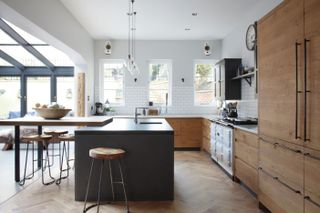
What's the cost of individual elements of a kitchen?
The question how much does a new kitchen cost actually has many elements to it, as you'll need to consider all sorts of things such as cabinets and handles, worktops, appliances, sinks and taps. Your kitchen needs to last, so think value as well as price tags to make best use of your budget.
'The most important thing with kitchens is to make sure the carcasses of the units are rigid and are a minimum of 18mm thick,' says Rob Lessmann, founder of Design’d Living.
'Flat pack units will save you money on unit cost but your install costs will go up so it’s worth working out the difference and seeing if you can afford a better quality unit.
'By going for a simple, handle-less design in matt or gloss you'll generally save money. Handles add a large cost to any design both for install and the cost of the handle itself.
'You can save money on appliances by going mid-range rather than high end too. Think of those that you’ll use most and invest there, then look at slightly more reasonable options for the appliances you won’t use as often.
'Sinks and taps can also provide cost savings and are often on offer, so shop around for the best discounts and see if they offer package options.'
Rob’s favourite worktops are quartz. 'It may cost more to start with but it will last,' he says. 'Worktops will start from £4,000 but will last the life of the kitchen.'
However, if you are on a tight budget, laminate work surfaces will prove cheaper, followed by wood. 'Stone will cost around £3,000 to £3,500 for a full kitchen,' says Malo Tasle, director at InHouse Inspired Room Design.
How much does a bespoke kitchen cost?
If you’re investing in a bespoke kitchen your costs will, of course, be higher.
'How much to spend on a new kitchen will be down to personal circumstances,' says George Forsyth of Drew Forsyth & Co. 'As a guide, new kitchen costs are usually 5 to 10 per cent of the value of your home.'
For a £30,000 kitchen, for example, the budget would break down as follows, he explains:
Furniture £9,000 to £11,000 (30 to 35 per cent)
Worktops £4,500 to £6,000 (15 to 20 per cent)
Appliances £4,500 to £6,000 (15 to 20 per cent)
Sink and taps £300 to £1,500 (3 to 5 per cent)
Delivery and installation £4,500 to £6,000 (15 to 20 per cent)
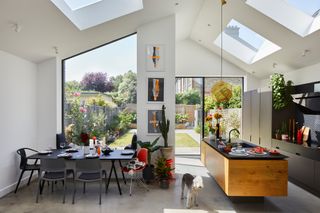
22 ways to make a new kitchen cost less
So, you've finally decided a kitchen revamp is in order. You've spent hours on Pinterest creating board after board of new kitchens inspiration; you've been to every kitchen showroom in the country; you've meticulously planned exactly what you want... Then, you receive the final quote.
Turns out that unless you want to remortgage your house or never go on holiday again, you are going to have to make your dream new kitchen cost less. Thankfully, kitchens on a budget are possible – and there are some simple ways to achieve just that.
1. Re-use materials to save on new kitchen costs
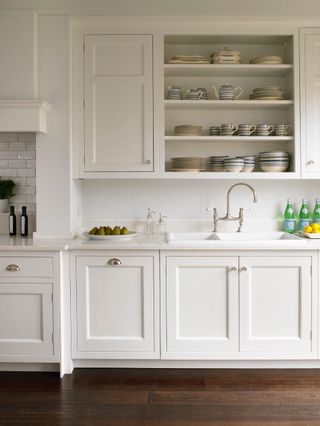
‘Most kitchen renovations start with the old kitchen going in a skip, but if you want to keep new kitchen costs to a minimum, think about what’s saveable,’ says experienced renovator Jason Orme.
‘In many cases the carcasses can be reused and, with a bit of work and new doors, will look as good as new. Countertops – particularly if they are solid granite or quartz – can be recut, saving you hundreds of pounds. ’If you have too few units, you may be able to buy more, or opt to use them on just one wall. Alternatively, consider using old units if you are planning a utility room too.’
2. Do the prep work yourself

You might want to DIY some of the preparation work to cut your spend. ‘If you can do some of the prep work yourself, this can save you a couple of days’ worth of work and will reduce the labour costs,’ says George Burrows, kitchen design expert at HomeHow.
‘Consider doing things such as scraping wallpaper, removing cupboards, and taking down wall tiles.’
3. Reduce wastage
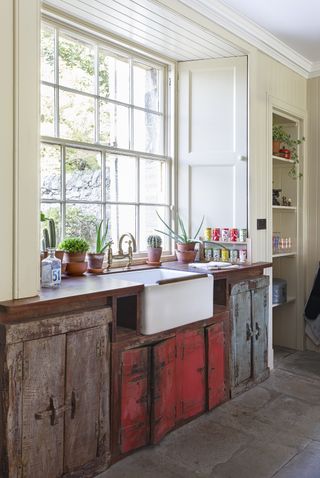
Just because your old kitchen is no longer to your taste, doesn’t mean it is scrap. If you’re not re-using existing materials such as floorboards, doors, radiators and units, they can be sold and the money can go towards your new kitchen costs. Try Ebay, Gumtree or contact your local reclamation yard.
How much might you gain by selling an old kitchen? ‘The valuation of your old kitchen will depend on several things: age, condition, original purchase price, brand and desirability,’ says Helen Lord, founder of Used Kitchen Exchange.
‘As a cautious valuation guide, halve the original purchase price and take £1,000 off this figure for every year you have used it. So, a 10-year-old kitchen with an original purchase price of £25,000 could be worth £2,500 or more, but like most things in life, the higher the original value, the more desirable the brand or design, the higher the selling price.’
‘It’s true that one person’s trash is another one’s treasure,’ agrees Laura Crombie, brand development director of Real Homes, Homes & Gardens, Ideal Home, Livingetc and Gardeningetc.
‘We sold our old kitchen and appliances for £350, as well as our old furniture, to help pay for the replacements. It’s much better for the environment than things going to landfill.’
Reducing wastage could also reduce the cost of your new kitchen, as you may not need to pay for a skip or disposal.
4. Be selective with expensive fittings
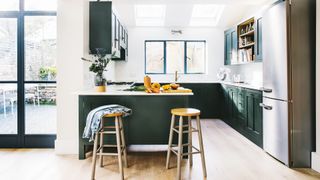
Simply having a few investment pieces paired with more budget buys will help ease kitchen renovation costs but still up the quality of your space.
‘If you can’t afford to fit out your whole kitchen with bespoke units, consider commissioning just a central feature, such as a statement kitchen island, and make up the rest of the kitchen using standard, basic quality units to cut new kitchen costs,’ says experienced renovator Michael Holmes. ‘The same can apply to worktops – use granite or similar for the island and then cheaper timber or laminate elsewhere.’
5. Rethink existing kitchen space
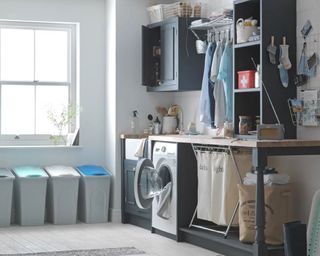
Remodelling and re-using existing space can solve many of the frustrations you have with your inherited kitchen. ‘Modern requirements for utility rooms, drying rooms and even larders can often be satisfied by making use of what’s already there,’ says Orme.
‘The obvious merging of a dining and kitchen area by knocking through could easily add two metres of space for a walk-in larder or utility room, for instance. This takes the pressure off the new kitchen when it comes to kitchen storage and usability, reducing new kitchen costs and minimising disruption.’
6. Reduce structural alterations in a kitchen renovation
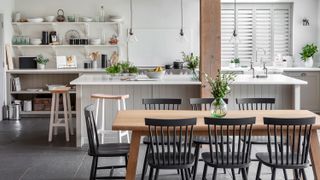
If you do not need to extend, then linking the old and new spaces so they flow seamlessly is not something to compromise on, but costs can often be reduced through thoughtful design.
‘For instance, retaining part of the existing walls or introducing a steel or concrete column can shorten spans and reduce the size and cost of the steel beams required,’ says Michael Holmes.
Extending a house to get the new kitchen you want? ‘It’s better value to add a square-shaped extension with a simple pitched roof, instead of adding complicated curves and angles,’ he says.
7. Choose end-of-line or display kitchens to cut new kitchen costs
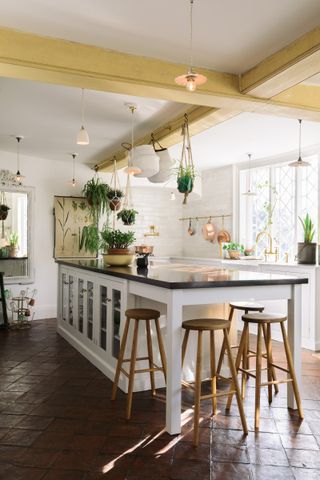
No one will ever know if your 'new kitchen' once stood in a showroom and you paid a bargain ex-display kitchen price.
‘If you’re extending, there may even be scope to design your space to suit an ex-display kitchen – and if you’re not, then the company will usually be able to add/remove a few units to make the kitchen work in your space,’ says Michael Holmes. End-of-line appliances, sourced online via specialist distributors, can also be real bargains.
8. Consider buying a used kitchen
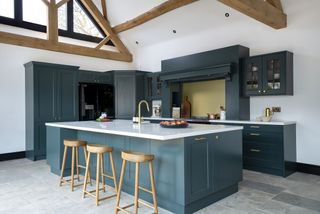
As an alternative to an ex-display kitchen, think about opting for a used one. It could enable you to get a high-quality design that your budget wouldn’t stretch to if it were new.
In order to ensure you will be happy with your purchase, inspect carefully. ‘If buying locally then always ask to view the kitchen prior to purchase or, if purchasing online, request lots of photos that show every angle and those that show details close up,’ says Helen Lord.
What about the size of the kitchen? ‘In the case of a pre-owned kitchen, buying one a little bigger than you need gives you far more flexibility with reconfiguration,’ says Lord.
9. Avoid moving utility meters and services
‘Unless it is an essential to radically alter the orientation or usability of a kitchen, try to keep the sink, dishwasher and cooker in the same position if costs are an issue,’ says Jason Orme.
‘That way, you’ll be minimising the amount of additional electrical, gas and plumbing work that is needed to realise the new design – and save hundreds of pounds in the process.’ And, if you can, avoid having to move your gas and electricity meters, as they cost £1,080-£1,320 each to relocate.
10. Shop smarter to cut new kitchen costs
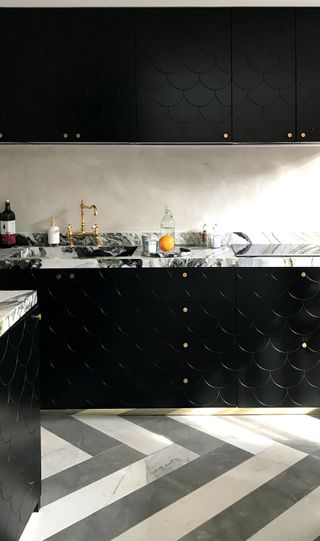
It can be all too tempting to walk into a beautiful showroom filled with new kitchens, but when you’re designing a kitchen on a budget, you need to check that it offers the best value for money. ‘The more you can plan ahead, the more chance you’ll have to shop around,’ explains Jason.
‘The cost of kitchen units, worktops, doors, taps, sinks and cooker hoods varies wildly and if you can wait for sales and spend time researching prices you can save £1,000s on the total cost.’
Consider shopping with online-only retailers, which don’t have the same overheads as companies with showrooms and can therefore keep costs down; but always check reviews and ask to see samples of everything before you order.
Or, go for a ready-to-paint kitchen and paint the kitchen cabinets yourself to make your new kitchen cost less. Here are some of our firm favourite kitchen cabinet colour ideas for inspiration.
11. Get cabinet door savvy
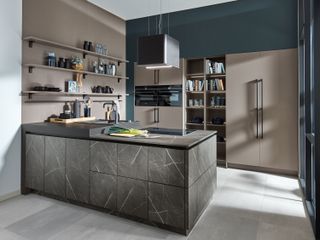
You can reduce your spend by opting for less expensive door options to create the look you want. ‘Cabinetry and doors represent a big part of the budget when buying a new kitchen, but you can save money by carefully choosing the type of material used,’ explains Richard Turner, Pronorm’s national sales manager for the UK and Ireland.
‘Materials used on door frontals vary in price but still give you the freedom to create the look you want. For example, if you want a matt kitchen style, then choosing matt laminate doors will give a similar non-reflective tactile aesthetic to a more expensive matt lacquer option, saving around 25 per cent on your kitchen furniture in the process.’
12. Can you fit new kitchens yourself?
Installation of the kitchen itself can be a key contributor to new kitchen costs – typically installers estimate £50 per 60cm element, plus extras, meaning a typical kitchen can easily cost £1,500 to £2,000 to install. You can cut this cost by installing the units and doors yourself from flatpack, which any medium-skill DIYer should be able to manage.
It’s also relatively easy to tile walls yourself to save on your kitchen renovation cost. ‘If you make sure that you have the right equipment to hand, properly prepare the surface you’re going to tile, and work carefully, tackling tiling can be a great way to save money when renovating your kitchen,’ says Harriet Goodacre, tile consultant at Topps Tiles.
Exceptions to the DIY rule? Always leave worktops and the electrical and plumbing elements to the professionals.
13. Upgrade a cheap kitchen carcass
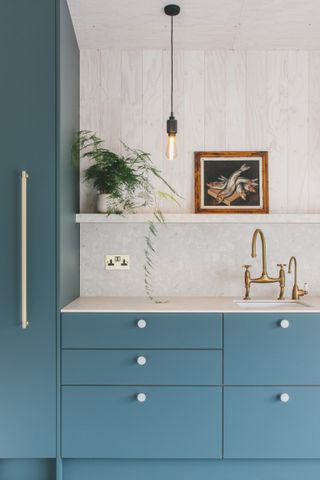
A recent trend in the world of kitchens, and definitely one that helps make a new kitchen cost less, is upscaling cheap kitchen carcasses from places like Ikea to give them a more expensive, bespoke look. Companies like Plykea and Husk make doors, drawers, worktops and more to fit Ikea's kitchen cabinets, but give your kitchen more of a handmade look.
It's really easy too. Simply design your dream scheme using the handy Ikea Kitchen Planner Tool, then send to your upscaling company of choice with your pick of doors, drawer fronts, cover panel facades and worktops, and they will do the rest. All the fronts arrive complete with pre-drilled holes and fixing holes that make them as easy to assemble as the rest of your flat-pack kitchen.
14. Mix vintage freestanding furniture with a new fitted kitchen
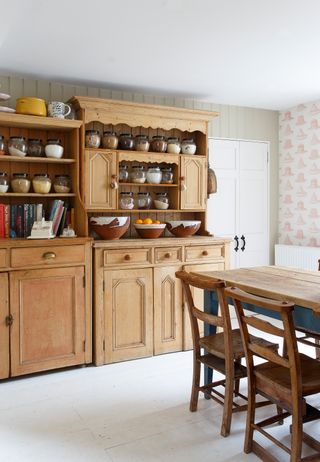
So you've had your heart set on a built-in, bespoke pantry cupboard or a gorgeous (but way too pricey) Welsh dresser?
Instead of blowing half your budget on one piece, cut the costs of your new kitchen by buying them secondhand. You'll find some gorgeous, cheaper, pieces on places like eBay, Etsy, even Facebook Marketplace has some gems.
Plus, we love the look of a few unique, freestanding pieces mixed into a new kitchen; it works particularly well if you are after a rustic, farmhouse kitchen look.
15. Add more worksurface space with a kitchen island
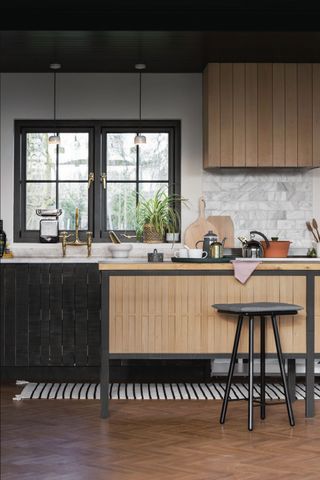
Need more worktop space in your kitchen? Consider a few kitchen island ideas – a much cheaper option than adding an extension or knocking down walls.
‘An island can be compact – from around 1m by 1m – and still be really useful, and you can scale up from there depending on the size of your room,’ says Lucy Searle, editor-in-chief of Homes & Gardens.
‘Bear in mind that an island does require sufficient space around it: cabinet doors, drawers, oven, and dishwasher doors opposite should open without obstruction, and the kitchen’s users need to move around safely. Factor in clearance of at least 800mm all round for the most compact island, and 1m or more for a larger version.’
If you really don’t have the space for a freestanding island? ‘You might want to consider integrating a seating nook into your kitchen,’ suggests Ruth Lavender, design expert at Benchmarx Kitchens and Joinery. ‘Incorporating a small bench into surrounding units can really maximise the area and positioning a small table in front can create a truly versatile feature. You don’t have to forgo storage either, as you can incorporate clever solutions beneath the seating area and in the surrounding space.’
But how much does a kitchen island cost? Find out more in our guide.
16. Repurpose parts of your old kitchen
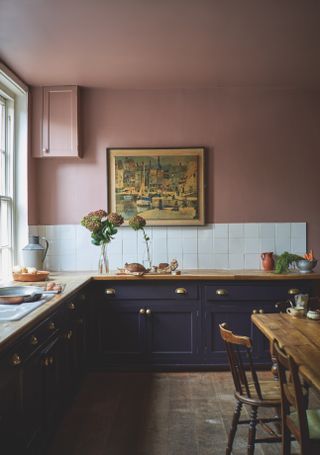
This goes without saying for appliances. If your larger appliances still work, such as your fridge freezer, then keeping them rather than replacing is an obvious way to cut back on your new kitchen costs.
It is possible to give appliances a new look, too. ‘Painting large kitchen appliances such as the refrigerator or a dishwasher is a fantastic way to upgrade an old kitchen appliance or change one to suit a new aesthetic: in a cottagecore kitchen, for example, an existing silver fridge may not quite fit in with the new look,’ says Michael Rolland, interiors expert and MD of The Paint Shed.
‘It is important, however, to make sure that the surface on the appliance, which is usually a high sheen, is prepped correctly and the appropriate and best kitchen paint is chosen.’
You can also repurpose or re-use parts of your old kitchen. Maybe your wooden worktop just needs a bit of TLC and you could upcycle it? You could also reuse it to create a kitchen island or a breakfast bar idea. The same goes for your kitchen doors: if you can't salvage them with a lick of paint, consider reusing them in a utility room or even your garage.
17. Shop the sales for your kitchen appliances
Don't overlook the fact that buying new kitchen appliances is going to substantially up your new kitchen cost, so make the most of sales!
Be on the lookout on big brands sites like Currys, John Lewis and AO.com because you can usually find deals all year round. Even if they aren't that obvious, search for clearance sections that are usually hidden away, sign up for newsletters so you know when sales are happening, or just keep an eye on our deals page.
18. Choose kitchen fitters wisely
Finding the right companies and tradespeople to work with could save you thousands, with even the same new kitchen cost varying between different builders.
Most kitchens come in set styles – for instance, Shaker kitchens or handleless units – so, once you’ve chosen the look you want, get quotes from at least three different kitchen companies or fitters to ensure you're getting the best deal.
Remember, the cheapest may not be the best if not all of your requirements are met. Follow the same process with plumbers, electricians, tilers and, if needed, installers, to ensure best value for money.
To find a good builder and avoid cowboy builders always ask for references from past clients and, if possible, visit homes where they have completed similar work. Finally, always get a written, itemised quotation so you know exactly what you will be paying.
19. Consider alternatives to a package service
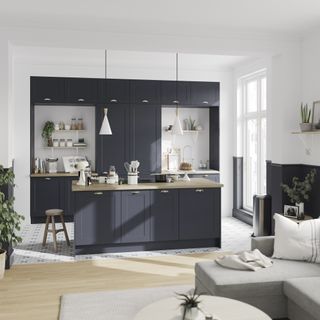
‘Rather than going for a package service that includes design, the products and appliances, and installation, shop around,’ says Laura Crombie.
‘You can often find a local kitchen fitter who will install your units far cheaper than a big kitchen company will. And if your DIY skills are up to it, consider installing the units yourself. Don’t attempt to fit worktops, though, it’s a specialist job and you need to know when to call in the experts.’
20. Know where to spend and where to save on a new kitchen
Where to save your money in a new kitchen
Appliances: If you’re changing your fridge-freezer, washing machine or cooker, take advantage of holiday sales and outlet stores for specific brands like Miele, Hotpoint or Whirlpool. It could be worth a trip to save £100s on your white goods, oven and hob.
And consider opting for integrated designs to save. ‘If they are hidden behind cupboard doors, you have the freedom to choose brands that are good quality but don't necessarily match the appliances that are on display,’ advises Graeme Smith, head of retail and commercial design at Life Kitchens.
Kitchen sink: A stainless-steel sink is hard-wearing, easy to clean, resistant to high temperatures, and cost-effective. But be wary of choosing the cheapest steel option as this may scratch and dent easily. Find out more about how to clean a stainless sink with our guide.
Kitchen tiles: Kitchen splashback ideas won’t be exposed to as much wear and tear as your flooring or worktops, so a budget-friendly ceramic can be just as good as pricey porcelain or cement options. Experiment with unusual arrangements; try laying great-value metro tiles in a herringbone pattern and fill with an on-trend coloured grout – simple but effective. Shop around for the best price.
Flooring: ‘Herringbone has risen to become one of the most sought-after kitchen flooring ideas thanks to its prominence on Instagram and Pinterest,’ says Josh Barber, buyer at Flooring Superstore.
‘To get the look with real wood planks or laminate options can be a time-consuming and costly home improvement, and it can result in a lot of materials being wasted due to the style of the pattern. However, vinyl flooring for kitchens is a great way to adopt this trend without breaking the bank or needing a lengthy installation.’
Drawers and pull-outs: ‘Cupboards cost significantly less than drawers and pull-outs,’ says Malo Tasle of InHouse Inspired Room Design.
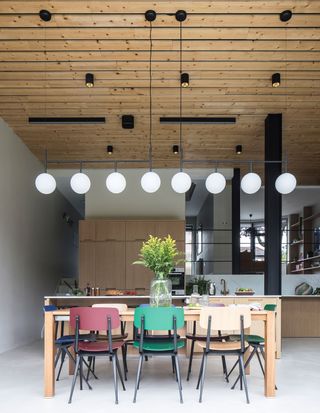
Where to spend your money in a new kitchen
Kitchen taps: In use every day, you want one which will not only look good, but will last. Consider size, shape and water pressure for a perfect fit. Boiling water taps, for example, are pricey but can look very stylish and can even be space-saving, avoiding the need for kettles and coffee machines.
If you do choose a boiling water tap, you can reduce the cost by considering both the functionality and finish. ‘You can save hundreds of pounds by choosing a standard 3-in-1 instant boiling water tap in classic chrome as opposed to a premium 4-in-1 electronically controlled model in a top-of-the-range metallic finish,’ explains Jo Sargent, sales and marketing director at Franke UK. ‘If instant boiling water is your main goal, they will both deliver this.’
Fixings: A quality fixing – we're talking door handles and knobs and hinges – will be long-lasting and allow ease of use. Even if you choose inexpensive cabinets, good fixings can make a huge difference.
Kitchen worktops: A natural focal point, they need to be hardwearing but you can get a variety of durable kitchen worktop materials. If you’re going for laminate, avoid cheap versions as they can chip and damage easily, while quality laminates can look convincingly like stone and composite. Timber is warm and stylish but requires maintenance. For a statement in an urban-style kitchen, consider stainless steel. Check out these DIY worktops too.
Love the idea of granite, but want a lower cost? ‘Quartz is a manmade stone that’s generally cheaper than granite,’ says Deborah Bond, CEO of Granite Worktops UK. ‘If you were to buy affordable quartz worktops brand new, you could choose a sparkly or marble-effect quartz. The veins make the worktop look more natural, giving you an expensive look without the high price tag. You could even go for a plain light grey quartz or a white quartz to give a modern and contemporary look.’
Corner units: ‘I would always recommend spending a little more on corner units, as well-engineered corner pull-outs are far superior to basic corner cupboards,’ says Malo Tasle. ‘They maximise every inch of space, and save you having to get on the floor to reach items at the back.’
Hob: Consider swapping to an induction hob in a new kitchen. ‘Induction hobs have taken both domestic and industrial kitchens by storm, making cooking smarter, faster, safer, and greener, whilst saving users money in the long run,’ says Ian Johnstone, strategic design manager at Stoves and Belling.
21. Go for shelves rather than wall units
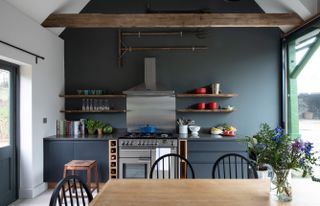
‘Try open shelf units instead of traditional wall units – these can create a great feature and can be less expensive,’ says Neil McDonald, design manager at Moores Kitchens.
Dawn Filkins, head of creative at Smile Kitchens, agrees. ‘Open kitchen shelving ideas are hugely on-trend right now and cost significantly less than your standard wall cabinet setup,’ she says.
‘Stylistically, this look can also make the kitchen space feel lighter and brighter, breaking up the density of wall cabinets. It also grants you a place to display favoured items such as china plates, vases, or artwork.’
22. Use laminate instead of lacquer or veneer finishes
If you love the look of timber but it’s beyond your budget, laminate can be a great alternative to cut your new kitchen cost quickly.
‘Laminate wood effects are an increasingly popular solution that evokes the rustic look we love to create with wood, without compromising cost,’ says Malo Tasle. ‘Modern laminates are incredibly durable.’
Join our newsletter
Get small space home decor ideas, celeb inspiration, DIY tips and more, straight to your inbox!
Laura Crombie is a journalist and TV presenter. She has written about homes and interiors for the last 17 years and was Editor of Real Homes before taking on her current position as Content Director for Country Homes & Interiors, 25 Beautiful Homes Period Living and Style at Home. She's an experienced home renovator and is currently DIY-renovating a 1960s house in Worcestershire. She's been quoted on home design and renovating in The Times, The Guardian, The Metro and more. She's also a TV presenter for QVC and has been a commentator for Channel 4 at Crufts dog show.
-
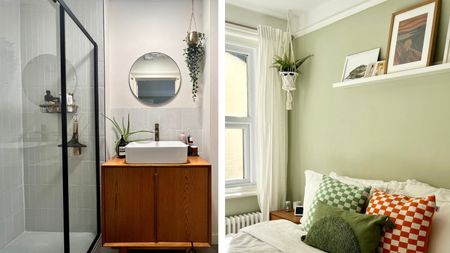 My first apartment makeover: 5 renovation mistakes I learned the hard way, and how you can avoid them
My first apartment makeover: 5 renovation mistakes I learned the hard way, and how you can avoid themThese are 5 things to avoid in your apartment makeover. Trust me, I learned these the hard way during my first renovation project
By Luisa Rossi Published
-
 Share your small space glow up to win $150 in the Real Homes competition
Share your small space glow up to win $150 in the Real Homes competitionShow off your creativity and DIY skills to win $150 and for the chance to be featured exclusively in Real Homes magazine
By Camille Dubuis-Welch Last updated
-
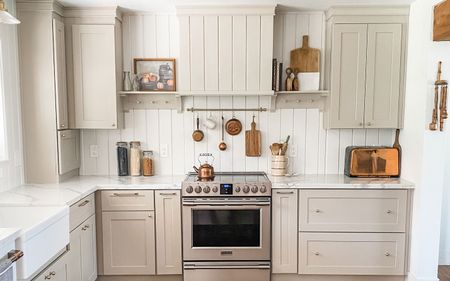 My DIY range hood and backsplash build gave my kitchen the perfect farmhouse finish
My DIY range hood and backsplash build gave my kitchen the perfect farmhouse finishI craved charm in my kitchen space and adding a custom range hood and shelving was the best move.
By Brooke Waite Published
-
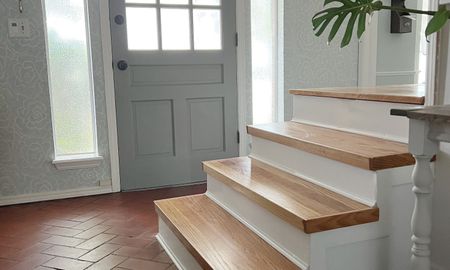 How to convert carpeted stairs to wood treads: a 5-step DIY
How to convert carpeted stairs to wood treads: a 5-step DIYConvert old worn-out carpeted stairs to wood treads DIY for a beautiful finish that will last for years to come. Plus, this stair riser project will cost a fraction of the price to pay a pro!
By Dori Turner Published
-
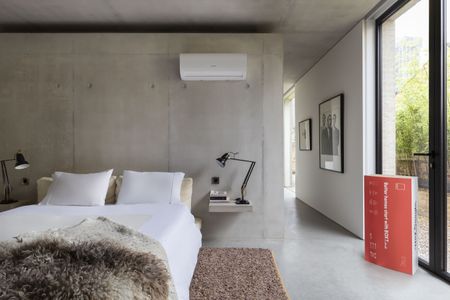 AC not working? Here are 8 things to check ASAP according to industry experts
AC not working? Here are 8 things to check ASAP according to industry expertsYour AC may not be working because the filter is clogged or you've got a tripped circuit breaker. Whatever the issue, getting to the root of the problem will lead to quicker solutions
By Camille Dubuis-Welch Published
-
 3 DIYs you should NOT do in a heatwave
3 DIYs you should NOT do in a heatwaveYou shouldn't clean windows on a hot day, you just shouldn't
By Camille Dubuis-Welch Last updated
-
 HGTV home renovator shares the most essential home repair you can do
HGTV home renovator shares the most essential home repair you can doHGTV's hottest renovator Carmine Sabatella debunks why this basic home maintenance job should not be forgotten
By Camille Dubuis-Welch Last updated
-
 15 telltale signs you're dealing with a cowboy builder and how to avoid them
15 telltale signs you're dealing with a cowboy builder and how to avoid themA cowboy builder is easy to spot, when you know the telltale signs. Here's how to avoid one so you don't end up out of pocket with a poor or even unfinished home reno job
By Lucy Searle Last updated


